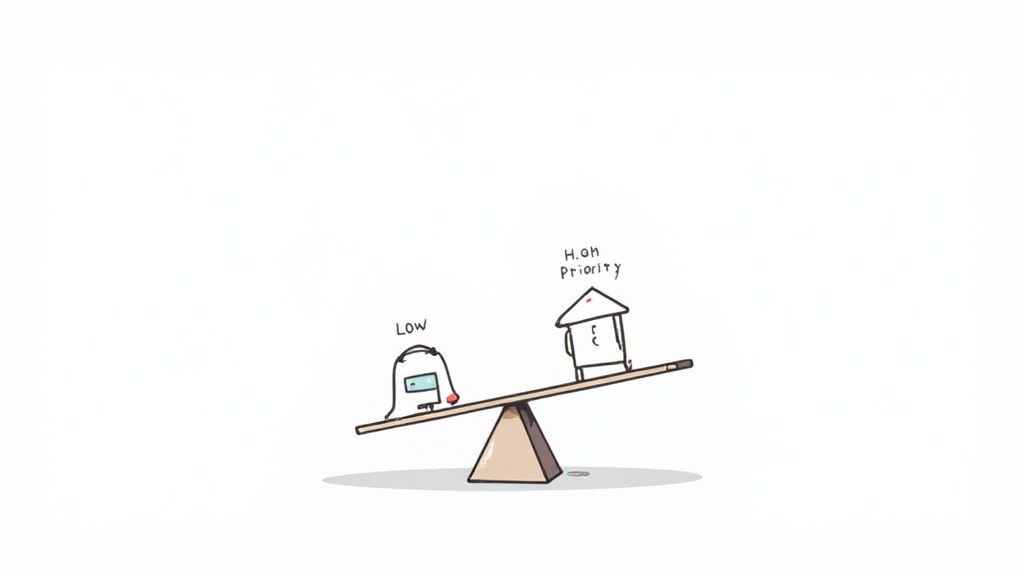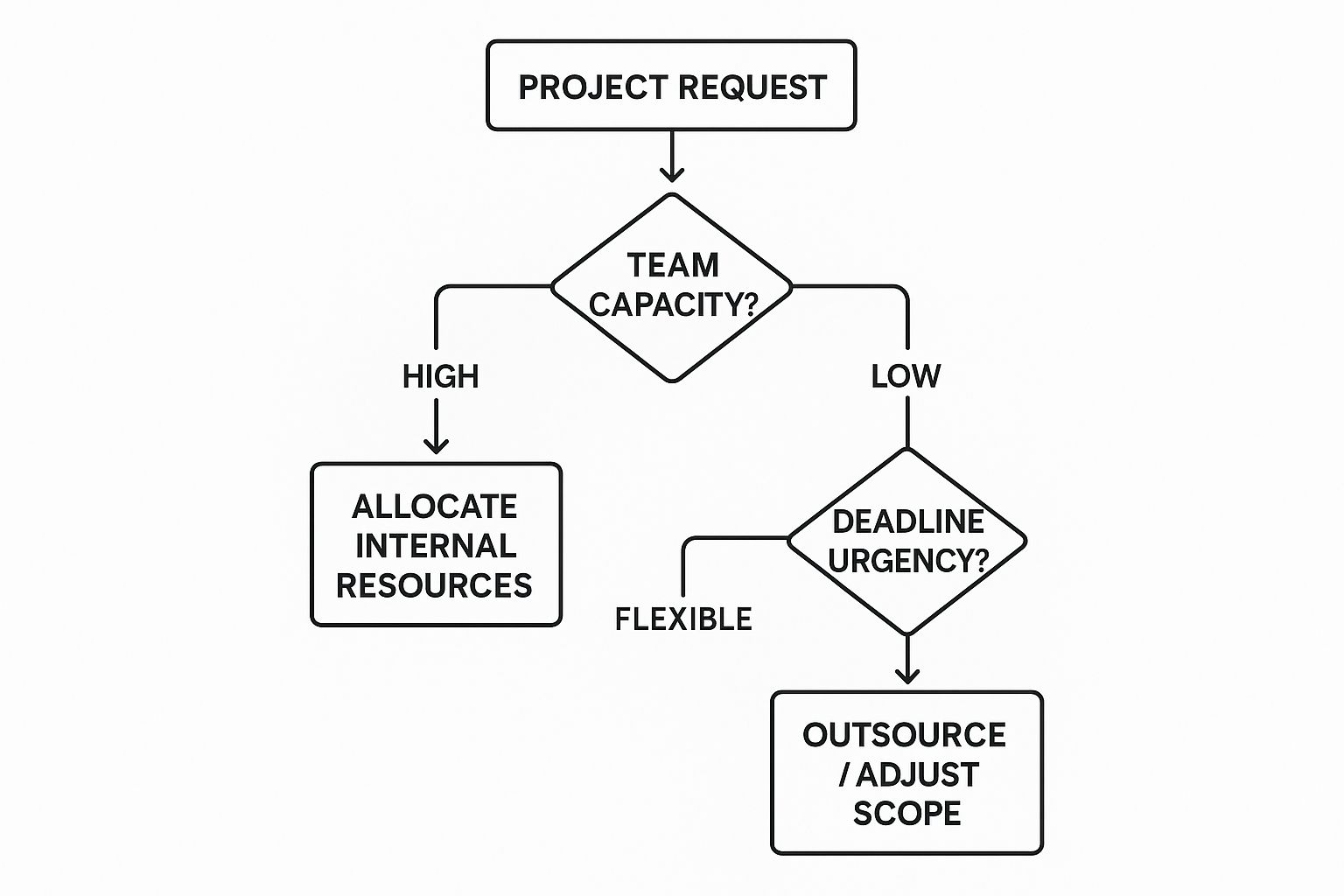
How to Manage Multiple Projects Simultaneously Like a Pro
Published
Welcome to the new normal for marketers. If you feel like you're constantly juggling five projects at once, you're not wrong. Having just a single project on your plate is a rare luxury these days. The real secret to keeping all those balls in the air isn't some magic app—it's about building a smart, repeatable system.
This system rests on three foundational pillars: creating a central 'mission control' for a bird's-eye view, being ruthless with your priorities, and keeping your communication lean and effective. This is how you stop reacting to chaos and start directing the show.
The Modern Marketer's Guide to Juggling Projects

If you're in marketing, this scene is probably familiar. One minute, you're deep in the zone planning a major campaign launch. The next, you're yanked into a last-minute meeting about a website redesign, all while the deadline for that quarterly analytics report is breathing down your neck. This isn't just a busy week; it's the job.
But this constant context-switching isn't just a personal time-management puzzle. It has real business consequences. You're definitely not alone in this—over 85% of project managers say they're handling multiple projects simultaneously. The problem is that this multitasking comes at a cost. In fact, nearly 10% of every dollar invested in projects is lost due to poor performance, which points to massive inefficiencies. If you're curious about the numbers, you can explore detailed project management statistics to see the full picture.
Ditching Chaos for a Real Framework
To get out of this reactive cycle, you need a system you can trust. Trying to manage everything with a mix of sticky notes, flagged emails, and random spreadsheets just leads to missed deadlines, frustrated stakeholders, and, eventually, burnout.
What you need is a personal operating system for your work. Think of this guide as the blueprint for building that system, based on battle-tested principles you can start using today.
We’re going to get practical and focus on three core areas:
- Your Mission Control: How to set up a single, reliable place to see everything—all your project details, timelines, and tasks.
- Ruthless Prioritization: The art of figuring out what really matters and focusing your energy on the tasks that move the needle for the business.
- Streamlined Communication: Creating simple, effective ways to keep everyone in the loop without drowning in meetings and notifications.
The big shift here is moving from being a passive task-taker to becoming the active manager of your own project portfolio. Getting that mindset right is the first and most important step toward regaining control.
Mastering these pillars will help you turn a tangled mess of competing priorities into a smooth, manageable workflow. It's how you'll not only survive but also demonstrate your value as a high-impact marketer who gets things done.
To give you a clearer picture, let's break down these core concepts. Think of them as the three pillars holding up your entire project management strategy. Each one supports the others, creating a stable foundation for your work.
The Three Pillars of Multi-Project Mastery
| Pillar | Core Principle | Key Action |
|---|---|---|
| Centralization | Create a single source of truth for all projects. | Choose and commit to one project management tool (like Trello, Asana, or Monday.com) to track tasks, deadlines, and resources. |
| Prioritization | Focus on impact, not just urgency. | Use a framework like the Eisenhower Matrix or Value vs. Effort to decide what to work on next, ensuring your time goes to high-value activities. |
| Communication | Be proactive, clear, and concise. | Set up a regular, predictable communication rhythm (e.g., weekly update emails or quick stand-ups) to keep stakeholders informed and reduce ad-hoc interruptions. |
By building your workflow around these three pillars, you create a system that’s robust enough to handle the complexities of modern marketing but flexible enough to adapt when things inevitably change. Now, let's dive into how to build each one.
Build Your Central Mission Control
You can't manage what you can't see. Trying to juggle multiple marketing projects in your head, or worse, across a dozen scattered spreadsheets and email chains, is a surefire path to missed deadlines and serious burnout. The first real step toward sanity is building a central "mission control"—a single source of truth that consolidates every task, timeline, and resource.
This doesn't have to be some overly complicated or expensive system. Your mission control could be a slick project management tool, a seriously souped-up spreadsheet, or even a massive physical whiteboard. The specific tool matters far less than the principle behind it: total visibility. Your goal is to create a master view where you can spot potential conflicts and dependencies long before they escalate into full-blown emergencies.
Choosing Your System
There's a reason the project management software market is exploding—it’s expected to reach $7.24 billion by 2025. Companies get it. In fact, 82% of organizations are already using these tools to get a better handle on their work.
When you're picking your own system, think about what you actually need.
- Kanban Boards (Trello, Asana): These are fantastic for visualizing workflow. If you think in terms of "To-Do," "In Progress," and "Done," Kanban is your friend. You can even set up a master board that pulls in tasks from individual project boards.
- Gantt Charts (ClickUp, monday.com): Perfect for those big, timeline-heavy projects where everything depends on something else finishing first. Gantt charts let you see exactly how timelines overlap and where you might have two teams needing the same designer at the same time.
- Custom Spreadsheets (Google Sheets, Airtable): Don't knock the spreadsheet! It's a flexible, low-cost option. You can design a dashboard that tracks the exact metrics you care about most, from budget spend to team workload.

Mapping Everything Out
Okay, you've picked your platform. Now for the real work. The heart of your mission control is mapping out every single initiative you're responsible for. This means getting granular for each project and documenting its key components in your new central hub.
A central dashboard isn't just about tracking tasks; it's about making strategic decisions. When you can see that two major campaigns both require your lead designer in the same week, you can address the bottleneck proactively instead of reacting to a crisis.
Getting this right really comes down to operational efficiency. For a deeper look into refining your workflows, explore how effective marketing process optimization can fundamentally change how you handle a diverse project load.
This becomes absolutely critical for remote teams, where clear systems are non-negotiable. If you're managing a distributed team, you might want to check out some remote work best practices to keep everyone aligned and on track.
Once all your projects are mapped out in one place, you'll finally have the clarity you need to make smart, informed decisions. You’re turning pure chaos into manageable order.
The Art of Ruthless Prioritization
When you're juggling multiple projects, everything can feel like a fire that needs putting out right now. But the secret to getting ahead isn't just about working faster; it's about being ruthless with your priorities. You have to consciously decide what truly moves the needle and what's just noise.
Let's walk through a classic marketing dilemma. You're tasked with finalizing a major website redesign, launching a new ad campaign that’s time-sensitive, and pulling together a comprehensive quarterly analytics report. All three are important. All three have stakeholders tapping their feet. So, where do you start?
The answer isn't just about which deadline is closest. It’s about which task delivers the most significant impact on your core business goals. This is where you need a system.
Find a Framework That Works for You
Relying on your gut to prioritize is a recipe for burnout and makes it nearly impossible to defend your choices to your boss or team. A solid framework gives you a logical, repeatable process for making these tough calls.
The Eisenhower Matrix is a fantastic tool for this. It’s simple but incredibly effective, forcing you to sort every task by its urgency and importance. Here's how it breaks down:
- Urgent & Important: Do these now. In our scenario, the ad campaign launch probably lands here if it's tied to immediate revenue.
- Important, Not Urgent: Schedule these. This is where strategic work, like the website redesign, often lives. It's crucial for long-term success but has some flexibility.
- Urgent, Not Important: Delegate these. These are the daily interruptions that can completely derail your focus.
- Not Urgent, Not Important: Ditch these. Seriously, just cross them off the list.
This decision tree gives you a quick way to think through new requests as they come in, helping you gauge whether you have the capacity or if something needs to be adjusted.

As the graphic shows, sometimes the right answer is to outsource or even scale back the project's scope, rather than trying to cram it all in.
To help you choose the best system, here’s a quick look at a few popular frameworks that are perfect for marketing teams.
Prioritization Frameworks for Marketers
A comparison of different methods to help you decide which tasks to tackle first across multiple projects.
| Framework | Best For | How It Works |
|---|---|---|
| Eisenhower Matrix | Quick, daily task sorting and avoiding time-wasting activities. | Categorizes tasks into a 4-quadrant matrix based on Urgency and Importance (Do, Decide, Delegate, Delete). |
| MoSCoW Method | Gaining stakeholder alignment on project features and deliverables. | Groups requirements into 4 categories: Must-Have, Should-Have, Could-Have, and Won't-Have. |
| ICE Scoring | Prioritizing growth marketing experiments or feature ideas with limited data. | Ranks tasks by scoring them on a 1-10 scale for Impact, Confidence, and Ease. The scores are averaged. |
| Value vs. Effort | Making fast, visual decisions with your team about where to focus first. | Plots tasks on a simple 2x2 grid, comparing the potential business Value against the Effort required to complete them. |
Each of these frameworks offers a different lens through which to view your workload, so pick the one that best fits your team's style and the nature of your projects.
Getting Stakeholders on the Same Page with MoSCoW
Another incredibly useful technique, especially for managing expectations, is the MoSCoW method. It's brilliant for getting everyone to agree on what's truly essential by bucketing tasks into four clear groups:
- Must-Have: These are the absolute, non-negotiable requirements for a project to be considered a success.
- Should-Have: Important, high-value items that aren't quite mission-critical.
- Could-Have: These are the "nice-to-haves" that you’ll tackle if time and resources allow.
- Won't-Have: Tasks that are explicitly off the table for this project or timeline.
When you apply this across all your projects, you get a crystal-clear, consolidated view of your real priorities. All the "Must-Haves" from every single project combine to form your true, non-negotiable to-do list. If you want to dive deeper into juggling these demands, there’s some great advice on managing competing priorities that can help maintain your focus.
The real point of prioritization isn’t just to make a tidy list. It’s to build a defensible plan that you can share with stakeholders, showing them why one task is getting done before another based on goals you all agree on.
By bringing this kind of structure to the chaos, you’ll not only feel more in control but also be able to turn a mountain of requests into a clear, actionable roadmap for success.
Using Time Blocking to Beat Context Switching
Let's talk about the real productivity killer when you're juggling multiple projects. It’s not the sheer volume of work; it's the constant mental whiplash from context switching. Every time you bounce from writing social copy to digging through campaign analytics and then jump on a quick call, your brain loses a little bit of steam. This constant shifting is exhausting, and it makes deep, high-quality work feel almost impossible.

The best defense I've found against this is a simple but powerful technique: time blocking. Instead of letting your day be a reaction to incoming pings and emails, you take control. You proactively carve out specific chunks of time in your calendar for specific types of work. This goes way beyond just scheduling meetings—it’s about scheduling your focus.
Imagine you're a marketing manager spinning plates on a new product launch, a quarterly content plan, and an SEO audit. Instead of flitting between them, you could create a two-hour "Content Creation Block" on Tuesday morning. During that window, you only work on writing tasks, whether it's the launch press release, a few blog posts, or the new meta descriptions. By batching similar activities together, you stay in one mental gear, which makes a world of difference in both your speed and the quality of your output.
How to Structure Your Week for Maximum Focus
You can take this a step further and apply this logic to your entire week by creating themed days. For anyone in marketing trying to keep multiple projects on track, this is a game-changer because it aligns your schedule with the different kinds of energy each task demands.
- Deep Work Days: Set aside one or two days a week for the heavy lifting. This is your time for strategic planning, creative brainstorming, and getting lost in complex data. Protect these days like a fortress—decline any meeting that isn't absolutely critical.
- Shallow Work Days: Use other days for the necessary but less demanding tasks. This is when you tackle your inbox, attend recurring check-ins, and handle administrative work. Having this dedicated time makes it much easier to ignore those distractions during your deep work sessions.
This approach gives your week a predictable rhythm and creates the mental space needed for both big-picture thinking and day-to-day execution. Mastering this is especially vital if you're working remotely. For more tips on that, check out our guide on work-from-home time management, which dives into creating focus outside a typical office.
The point of time blocking isn’t to build a schedule so rigid it shatters. It’s about creating a default plan that guards your most important asset: your attention. When life inevitably throws a wrench in your plans, you have a solid structure to return to.
Making Your Time Blocks Actually Stick
Of course, just dropping colorful blocks onto your Google Calendar is the easy part. The real challenge is defending that time. Urgent requests and "just a quick question" interruptions are always going to happen.
Be upfront and communicate your system to your team. A simple, "Hey team, I'm blocking off 9-11 AM for deep work on the Q3 launch, so I'll be slow to respond on Slack then" can work wonders. Setting these expectations helps train people to respect your focus time. Use your shared calendar and status tools to your advantage—a "Focusing" status on Slack is a clear, polite signal that you're in the zone. It’s a small step, but it’s how you start taking back control of your day.
How to Streamline Stakeholder Communication
When you’re juggling multiple projects, communication can feel like a full-time job. Those “just checking in” emails and endless status meetings don’t just eat up your day; they create a lot of noise that pulls everyone away from the actual work.
I’ve found the only way to survive this is to get out in front of it. You need to build a communication system that’s so reliable and proactive, people stop asking for one-off updates because they know exactly when and where they’ll get the information they need.
Instead of fielding random requests, what if you sent out one consolidated progress report every Friday afternoon? It shouldn't be a novel—think of it more like a high-level dashboard. For each project, just list the essentials:
- Status: On Track, At Risk, or Delayed.
- Last Week’s Win: One key accomplishment.
- Next Week’s Focus: The main priority.
This simple shift to a consolidated report immediately shows you respect everyone’s time. More importantly, it positions you as the organized, reliable source for what's happening.
Running More Effective Meetings
Meetings are usually the biggest culprit when it comes to wasted time, but you can't get rid of them completely. If you have the same stakeholders across several projects, try running one multi-project check-in instead of scheduling three separate meetings. The secret is a ruthless agenda and an even more ruthless clock.
Here’s an agenda structure that has worked wonders for me:
- Overall Health (5 mins): Kick off with a quick "traffic light" summary (red, yellow, green) for every single project. No long speeches here.
- Blockers Only (Bulk of the time): This is where you focus. Dive deep only into the projects marked "at risk" or facing major roadblocks. This ensures your time is spent solving actual problems.
- Action Items (Final 5 mins): End the meeting by clearly stating who is doing what next and by when.
Adopting this "blockers-first" approach is a game-changer. You stop having meetings that could have been an email and start having problem-solving sessions that move things forward.
The most powerful shift you can make is from reactive reporting to proactive alignment. When stakeholders know they will receive a clear, consolidated update every week, their need to ask for one-off updates diminishes significantly.
Embrace Asynchronous Updates
Your project management tool is your secret weapon for cutting down on noise. Whether you use Asana, Slack, or another platform, create dedicated channels or tasks for each project. Then, get your stakeholders to "follow" or subscribe to the projects they care about.
This creates a space for real-time, asynchronous updates that don't interrupt anyone's flow.
Imagine this: your designer finishes the mockups for the new campaign. Instead of drafting an email, they just post the files directly to the project’s task thread in your PM tool. This instantly notifies the right people, creates a clean chronological record, and avoids yet another meeting.
This is how you give everyone the information they need, right when they need it, without derailing your own focus. It's about building a system where information flows naturally, not forcefully.
Why This Is Your Most Valuable Career Skill
Let's be honest. Juggling a dozen projects at once feels less like a skill and more like a survival tactic. But I'm going to let you in on a secret I've learned over my career: mastering this chaos is the single most powerful thing you can do to accelerate your professional growth.
When you can confidently manage multiple moving parts, you stop being just another marketer on the team. You become the go-to person, the reliable engine that drives results. This isn't just about getting through your week; it's about building the foundation for your next big move.
Becoming an Indispensable Asset
Think about the senior leaders you admire. They aren't just experts in one specific area; they're conductors of an orchestra, guiding numerous complex, overlapping initiatives toward a common goal. When you prove you can handle that level of complexity with poise, you're signaling to everyone that you're ready for more responsibility.
In today's marketing world, companies are desperate for people who can drive growth on multiple fronts simultaneously. This skill is a huge green flag, showing you have the organization, strategic thinking, and communication chops to lead. If you're even thinking about a new path, sharpening this ability is essential. It's a core piece of any solid career change advice and planning.
And this isn't just a hunch; the data tells the same story. The Project Management Institute (PMI) projects a massive talent gap, with a need for up to 30 million new project professionals globally between 2025 and 2035. This demand is driven by companies needing experts who can handle exactly this kind of multifaceted work. You can discover more insights about the growing talent gap on PMI.org.
By developing your ability to manage multiple projects, you are not just improving your daily workflow; you are actively investing in your future value to any organization. This skill is a direct pathway to becoming a more strategic and influential professional.
Ultimately, this skillset is what separates the good marketers from the truly great ones. It proves you can turn strategy into execution, even when things get messy. This is how you distinguish yourself and become a future leader, not just another person on the team.
Got Questions? We’ve Got Answers on Managing Multiple Projects
Even the most organized marketing pro hits a wall when juggling multiple projects. It’s totally normal. You’re bound to run into sticky situations that demand more than just a good to-do list.
Here are some of the most common questions I hear from marketers in the trenches, along with practical advice for how to handle them.
What’s the Best Project Management Software?
Honestly, there's no magic bullet. The "best" tool really boils down to your team's specific needs—how big is your team, how complex are your projects, and what’s your budget?
If you’re a visual planner, you’ll probably love the card-based systems of Trello or the clean interface of Asana. For teams needing heavy-duty features like in-depth resource management or complex integrations, something like Monday.com or Jira might be a better fit.
The most important thing is to find a platform that gives you a single, centralized dashboard. You need to see every project's status, priority, and deadline at a glance. Start by pinpointing your biggest pain point (is it task tracking? resource planning?) and then abuse those free trials to see which one feels the most intuitive for you and your team.
How Do I Deal With Conflicting Priorities From Different Bosses?
Ah, the classic tug-of-war. This is where you have to shift from being a doer to a strategic partner. The answer isn't to just work faster; it's to create transparency.
Don't get caught in the middle. Instead, bring both managers into the conversation, armed with data.
Show them your master project plan. Walk them through the real-world impact of their requests. For example, you could say, "I can absolutely prioritize Project A, but I want to be upfront that it will push the launch of Project B back by three days. Can you help me confirm which one is the bigger priority for the company right now?"
This approach reframes you as a proactive problem-solver, not a roadblock.
What Are the First Signs of Burnout I Should Watch For?
Burnout is sneaky. It often starts small. You might feel a constant sense of being overwhelmed, or maybe you're just not excited about tasks you used to enjoy. Other early red flags include getting easily irritated or making silly mistakes you normally wouldn't.
The key to prevention is setting firm boundaries. Use time-blocking to schedule your day and be ruthless about protecting your "deep work" windows from interruptions.
Get comfortable saying "no"—or, more diplomatically, "not right now." Offer an alternative timeline that works. For a deeper dive into this, you can explore some advanced project management strategies for multiple projects. Most importantly, you have to schedule real downtime and fully disconnect. Your energy and focus depend on it.
Ready to accelerate your career in the influencer marketing space? At Influencer Marketing Jobs, we connect talented professionals like you with top opportunities, from entry-level roles to senior leadership positions. Find your next job today!